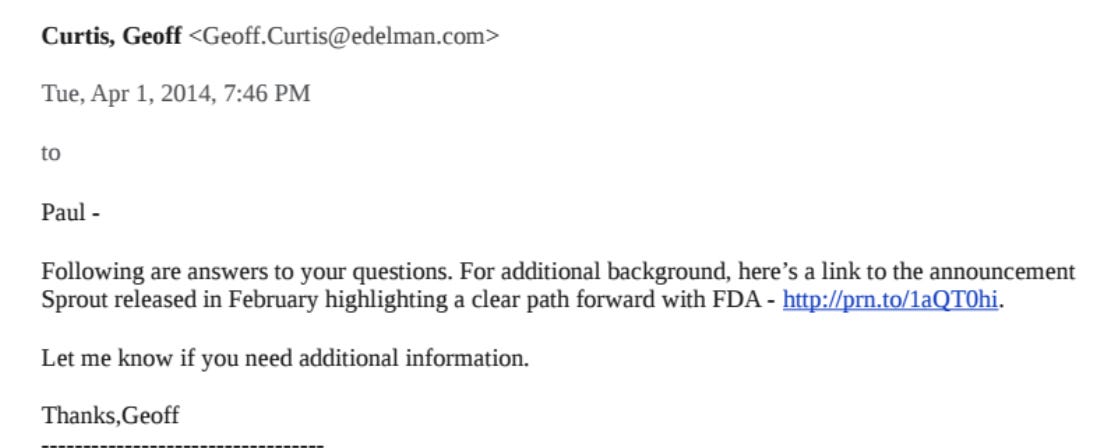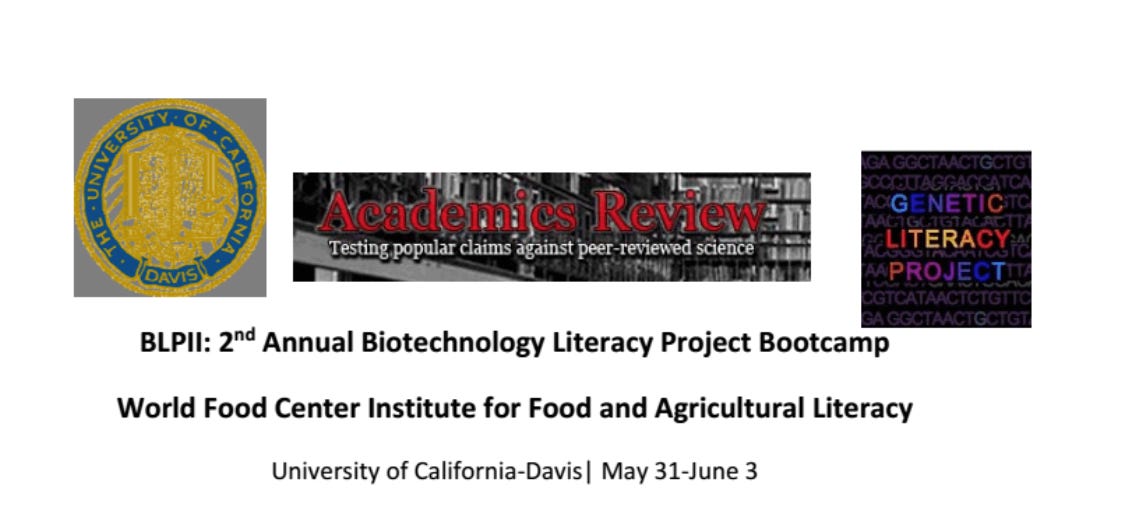Uncovering Corporate Front Groups and PR Campaigns
Doing for yourself what too few journalists do for you.

Every year I give a lecture for a graduate course at Georgetown where I include a presentation on corporate manipulation of the media and the public. No corporate PR campaign can succeed unless it either fools or co-opts journalists, and few readers understand how corporate front groups and propaganda campaigns warp public discussion. Pointing out a few examples, I hope, will prepare these students to be better news consumers.
Corporate PR campaigns began in earnest in the early 20th century, and while various thinkers helped formalize how they work, scholars credit Edward Bernays as the “father of public relations.” Bernays was the nephew of psychiatrist Sigmund Freud and his most famous book is notably titled “Propaganda.”
For the first example in the class, I discuss a PR campaign to attack the Food and Drug Administration (FDA) as “sexist” for not approving a drug called “flibanserin” which was marketed as “Pink Viagra.” I tripped across this campaign one day in 2014 while reading a story in The Prospect written by Amelia Thomas-Deveaux titled, “Why Don't We Have Viagra for Women Yet? The FDA's kinda sexist.”
The story recounted a tale of woe: the FDA was demanding that a small company named Sprout Pharmaceuticals get more data before the agency would approve flibanserin which allegedly enhanced the libido of women with a condition called hypoactive sexual desire disorder (HSDD). The writer accused the FDA of a “double standard when it comes to sexual dysfunction drugs” because the agency had approved Viagra and a slew of other drugs for men who couldn’t get erections.
As I read the article, I realized it was a complete mess. At the time, a woman ran the FDA, and the person in charge of drug approval, Janet Woodcock, is also a woman who has long been accused of favoring drug companies. What kind of crazy FDA sexism could this be when women running the FDA were allegedly standing in the way of approving a drug for other women?
It was such a weird argument.
Second, flibanserin was treating sexual desire, a very vague behavioral condition that I guessed likely involved manipulating the brain’s neurotransmitters. (Indeed, I later found out that flibanserin had been first proposed as an antidepressant but had been denied FDA approval.) Meanwhile, the male erectile drugs have a completely different mechanism of action, causing smooth muscle relaxation. In short, these drugs have nothing to do with each other, and comparing them makes no sense.
This odd story stuck with me, and a few days later I decided to Google “FDA and sexism” and found other stories that echoed the same narrative. An article in HuffPost by Dr. Anita Clayton (The FDA, Sexual Dysfunction and Gender Inequality) claimed that the FDA’s lack of approval for flibanserin was an example of societal “gender bias.” And a Washington Post article by reporter Sandhya Somashekhar (‘Female Viagra’ finds difficult path at FDA) repeated many of the same claims from Dr. Clayton’s article, and forced the FDA to deny that they were guilty of gender bias. Finally, a third piece in The Atlantic by Allie Jones (Three Reasons We Still Don't Have Female Viagra) argued that denying approval of flibanserin was not only evidence of “underlying institutional sexism” but something even more frightening: “blatant, medieval sexism is also at play.”
In short, I now had four articles, all written by women, that ignored medicine and the FDA regulatory process, while advancing some awkward feminist argument to harangue the FDA to approve a drug. I also found that one of the authors, Dr. Anita Clayton, was a consultant to Sprout pharmaceuticals. And when I looked up the experts the reporters cited in their articles, I found that Sprout Pharmaceuticals was also paying many of them—something that the journalists hadn’t bother to report. I also went to Sprout Pharmaceuticals website and found this company, which had gotten loads of media attention, had only eight employees.
Something wasn’t smelling right. A tiny company had gotten tons of media attention and the stories all contained similar talking points. I was pretty sure I was uncovering a well-funded campaign run by a PR company to contact reporters and spread this company’s narrative.
As I later wrote for Slate, I then interviewed several experts who work on sexual disorders in women and learned that Sprout was trying to get flibanserin approved for a fake condition. Hypoactive sexual desire disorder, which Sprout claimed flibanserin treated, no longer existed as a medical diagnosis. One of the women I interviewed pointed to a study she had published in PLOS Medicine eight years prior that documented the history of female sexual dysfunction as “a textbook case of disease mongering by the pharmaceutical industry and by other agents of medicalization.”
When I contacted Sprout for comment, they put me in contact with Edelman, the largest PR company on the planet. This explained how a tiny company had garnered such outsized and favorable attention from journalists.

As I discovered, the company had weaponized feminism to create a better narrative for itself. Instead of a story about a drug that likely didn’t work and treated a nonexistent condition, reporters had written stories about sexism at the FDA. As one expert told me for my Slate article, “It is hard to see what is sexist about the national drug regulatory agency refusing to approve a drug that was ineffective and like all active pharmaceutical products, has the potential for harm.”
But in reality, hijacking feminism to sell a corporate product is a decades old tactic. To sell cigarettes, Edward Bernays hired women to march in New York City’s 1929 Easter Parade while smoking their "torches of freedom." At the time, smoking was considered inappropriate for women and a sign of loose morals. But Bernays’ publicity stunt turned these social norms on their head, arguing that smoking challenged patriarchy in the fight for equal rights.
Despite my reporting, the FDA later approved flibanserin. I collected more background on the husband-and-wife team who ran Sprout Pharmaceuticals and passed it off to one of scientists studying sexual disorders in women. She then passed the information to the Associated Press.
Prior to starting Sprout, the couple had run Slate Pharmaceuticals, which sold an implantable testosterone pellet, called Testopel, for men with low levels of the hormone. Testopel later became the second most-prescribed testosterone treatment among urologists. But the FDA later sent the company a warning letter for making “misleading, unsupported and inaccurate statements” in marketing material. In one example, the company suggested on its website that Testopel could benefit patients with depression, diabetes and HIV.
After winning approval for flibanserin, the couple sold Sprout Pharmaceuticals to Valeant for around $1 billion. When sales of flibanserin tanked for a variety of reasons, such as the fact that the drug didn’t really help women with low sex drive, Valeant later offloaded Sprout.
In a second example, I explain to students how to track down corporate front groups. These are nonprofits disguised to look like public interest organizations to help amplify corporate messaging.
Back in 2015, I read an article (Seed Money: True Confessions Of A GMO Defender) by science writer Brooke Borel in Buzzfeed about her attendance at a conference held at UC Davis to discuss genetically modified organisms (GMO) agriculture. In the story, she wrote, “I was offered an honorarium to attend, which I declined, but the organizers did pay for my travel and lodging.”
Borel expanded on the ethics of reporters having their expenses picked up in an article for Popular Science (On Science Journalism And Conflicts-Of-Interest). I reported a similar article a month later on conflicts of interest in science journalism for the Columbia Journalism Review (Where do science journalists draw the line?), noting that there seemed to be no standards on whether outside groups could pick up journalists’ expenses and finding that few media outlets reported on their sources’ financial interests.
I’ve spent a lot of time on conflicts of interest, drafting and helping to pass a law on the issue when I was in the U.S. Senate, and helping to reform the conflicts of interest policy at the National Institutes of Health. I haven’t just thought about it once; I have spent hundreds of hours on conflicts of interest, discussing it with dozens of experts and giving talks on financial influence in science at several universities.
Something about Borel’s article in Popular Science just didn’t seem right, with one section catching my eye:
The conference in question was called the Biotech Literacy Project Boot Camp. I was invited to attend and to speak on some panels, although it wasn’t initially clear what that would involve. I was offered a $2,000 honorarium, as well as expenses. I wrote back and asked who would provide the honorarium and was told it’d be a combination of funds from UC Davis, USDA, state money, and the Biotechnology Industry Organization (BIO).
Now, BIO is an industry group. When I saw it listed, I decided then that if I went to the conference, I wouldn’t take that money, because I cover GMOs here at Popular Science as well as at other outlets.
Searching on the internet, I found a flyer for the conference, which noted that it had been sponsored by three organizations: UC Davis, a group run by academic Bruce Chassy called Academics Review, and a group run by former reporter Jon Entine called the Genetic Literacy Project. Both Academics Review and the Genetic Literacy Project were groups that I had long suspected were funded by industry.

Looking at the flyer, I realized that Borel hadn’t attended a GMO bootcamp or conference “funded in part by industry.” She had attended a conference sponsored by corporate front groups. And the job of a reporter is to expose, never to collaborate with corporate front groups.
Over the next year, I began going through thousands of pages of Monsanto documents that became public through court cases and freedom of information requests. Writing for Chicago’s NPR station, reporter Monic Eng revealed internal documents from Chassy’s university showing that Monsanto had been funneling money to Chassy through the University of Illinois Foundation to fund him to speak, write, and lobby federal officials about GMO regulation.
Other emails from 2010 found that Monsanto had set up Academics Review for Chassy. “The key will be keeping Monsanto in the background so as not to harm the credibility of the information,” a Monsanto executive wrote to Chassy. These emails proved that Academics Review was just a Monsanto front group.
As for the Genetic Literacy Project (GLP), Tom Philpott had reported for Mother Jones in 2012 that court documents found that Jon Entine had a friendly relationship with the agribusiness firm Syngenta and that he ran a PR firm that listed Monsanto as a client. I also found a memorandum of understanding (MOU) signed by Entine with Pamela Ronald at UC Davis. In that MOU, Entine promised that the bootcamp would be funded by BIO, with no mention of funding from UC Davis, the State Department, or USDA.

Borel had reported that this UC Davis bootcamp was funded by UC Davis, the USDA, the State Department, and BIO, so I just contacted all four of them. Both the State Department and USDA denied funding the bootcamp conference. While the conference had been held at UC Davis, the university denied providing any financial support.
I then contacted BIO and executives at the trade organization confirmed that they gave Academics Review $175,000 for a 2014 GMO bootcamp at the University of Florida and $165,000 for the 2015 conference at UC-Davis. But BIO added that they ran the money through a nonprofit they operated called the Council on Biotechnology Information (CBI).
When I pulled the tax forms for CBI, I found that they reported giving $300,000 to Academics Review in 2014 and $350,000 2015. These grants represented the majority of funding for Chassy’s Academics Review.

Borel’s piece at Popular Science was never corrected, and the industry funded bootcamps helped to spread a message among reporters that GMO products were safe as were pesticides. In an article I wrote for The Progressive, Marion Nestle, professor of nutrition, food studies, and public health at New York University, said, “If journalists attend conferences that they are paid to attend, they need to be deeply suspicious from the get-go.” The conference organizers, Nestle added, were likely trying to convince journalists that people questioning the safety of GMOs are “anti-science and in the same category as climate change deniers.”
The point to readers is to always beware of what you come across in the news. Corporate messaging often lurks in the background.




The “Global Farmers Network” is another new front group by Syngenta.